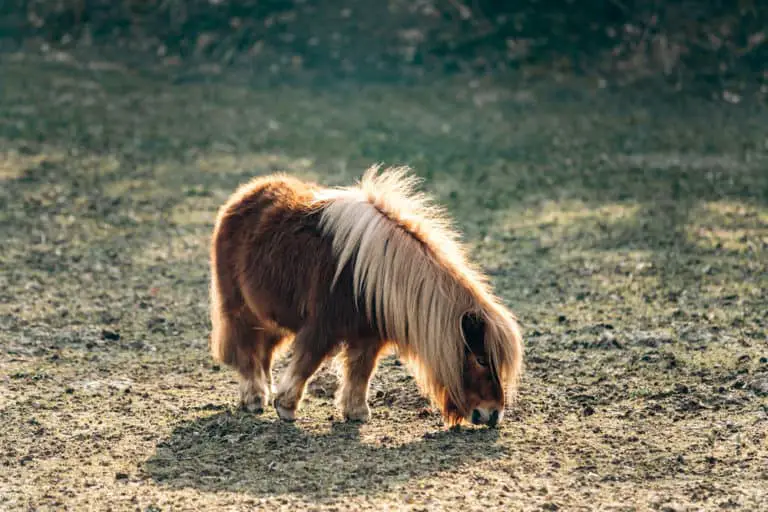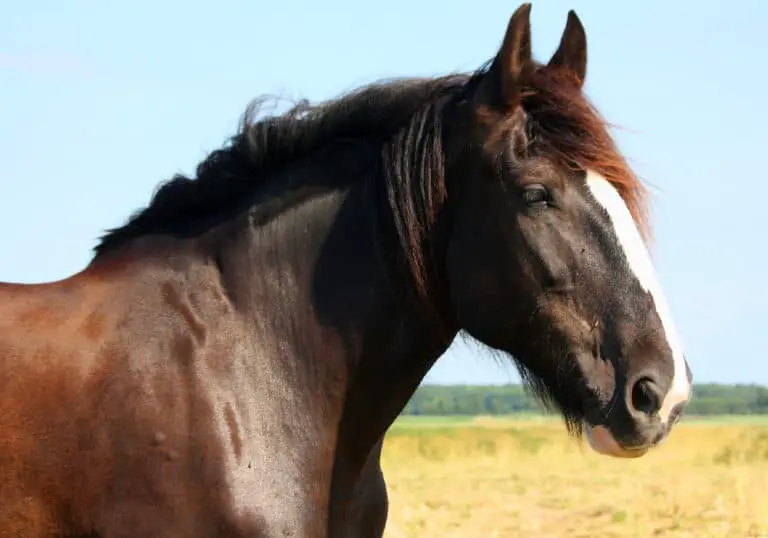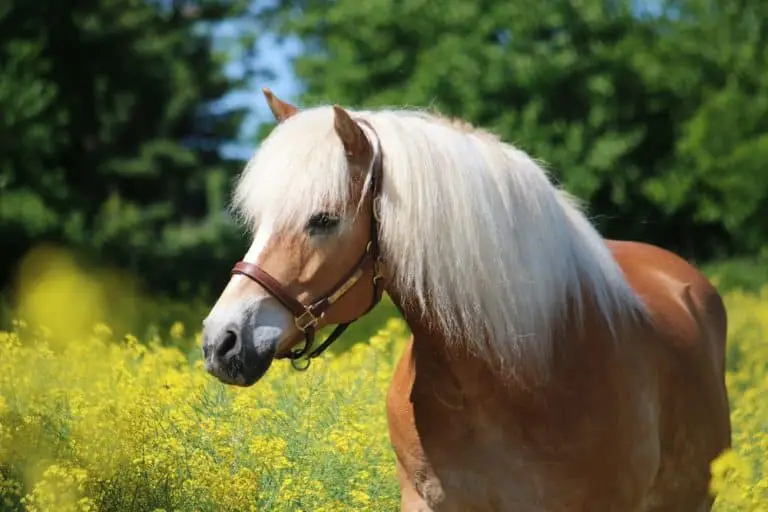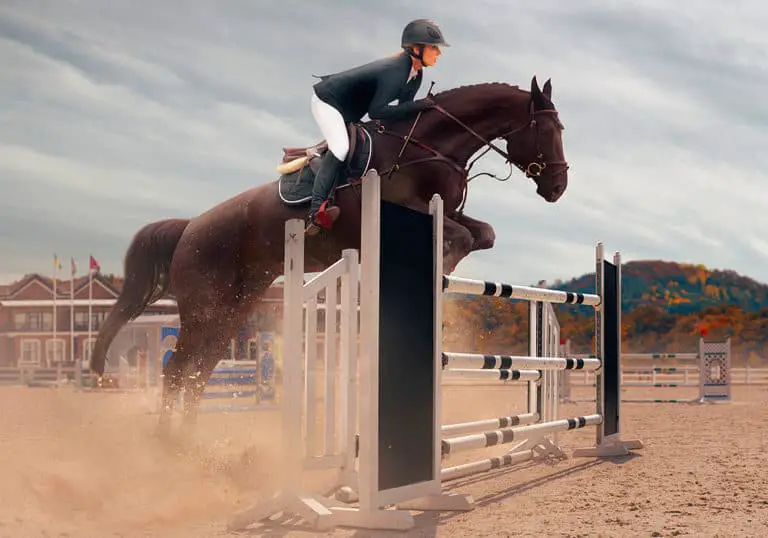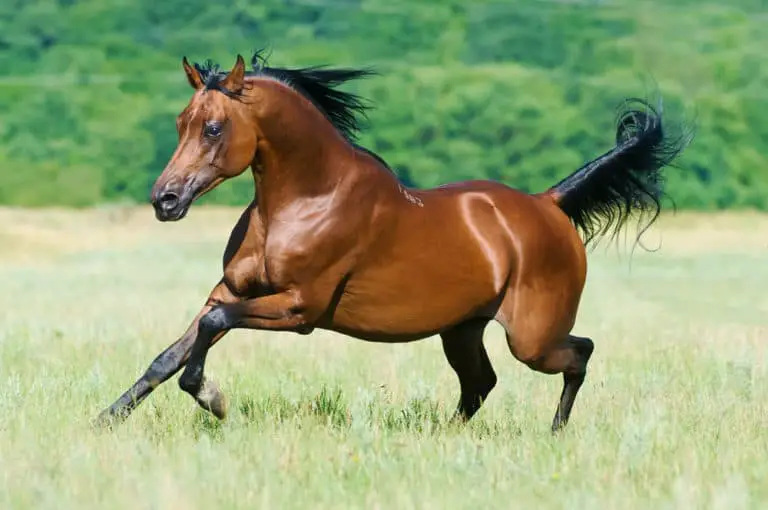Saddlebred Horse Breed: Care, Cost & History (2025)
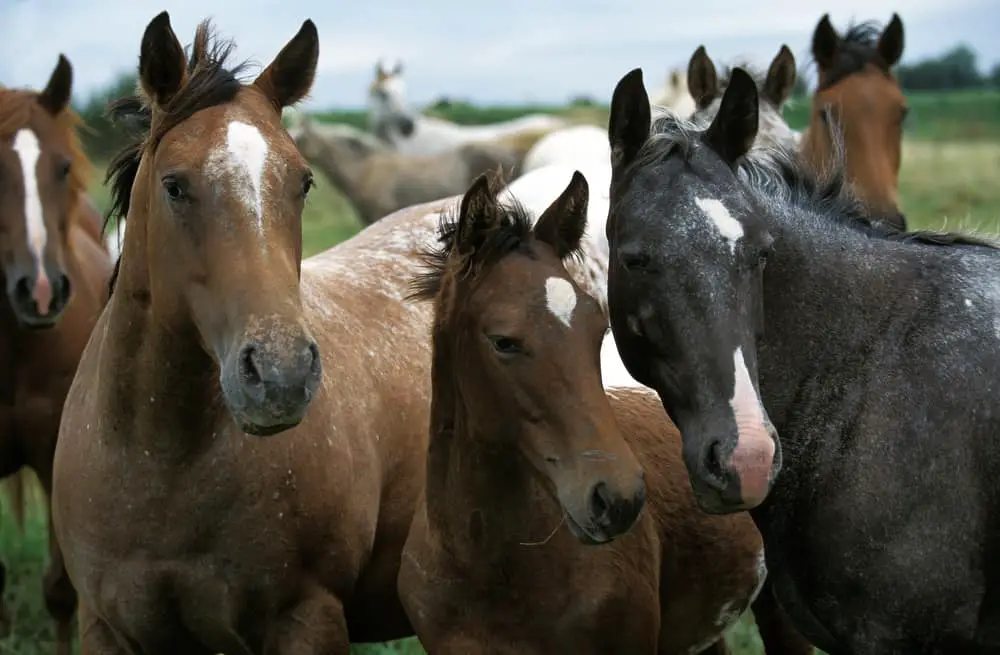
The Saddlebred horse originated in the United States as a riding horse and is known for its animated leg action and popularity as a show horse. The breed performs the normal walk, trot, and canter. They can also be trained in two four-beat gaits, the slow gait and rack, which are smoother and faster.
Breed: Saddlebred horse
Adult Weight: 800-1,200 pounds
Adult Height: 15.1-16.3 hands (61-67 inches)
Origin: United States
Use: Show, pleasure riding
Colors: All colors
Features: High stepping leg action, high head, and tail carriage
Lifespan: 25-30 years
Character: Calm and friendly, enjoy learning, and is people-oriented
Gait: Spirited, animated leg action, smooth
Best for: All levels of riders
- Characteristics
- Saddlebred Care
- Saddlebred History
- Modern Saddlebreds
- Cost and Ownership
- Buying a Saddlebred
- Similar Breeds
Saddlebred Horse Characteristics
Saddlebred horse characteristics are elegant, distinguished, and noble. The Saddlebred horse head has large wide-set eyes and fox-like ears on a long, arched neck that sits high out of their laidback shoulder. This allows the horses to have the animated leg action the breed is known for. The legs and body are both long, with an arched tail.
Size
Average Saddlebred horse height is between 15.1 and 16.3 hands tall, or 61 to 67 inches at the withers. Some are as little as 14 hands or as tall as 17 hands. (1) The high head carriage makes the Saddlebred size appear taller than they are.
Non-adult horses are full-grown between the ages of four and five, although most of their height (89%) is reached by one year of age. Adult male horses tend to be slightly taller than adult female horses.
The Saddlebred’s height, along with their long legs and body structure allows the animated leg action where the knees come up parallel with their chest as they are moving.
Weight
Saddlebreds are tall, elegant, and lean horses. As such, the average Saddlebred horse weight is between 800 and 1,200 pounds. Again, the male horses tend to weigh slightly more than female horses.
Bone structure is extremely important in the breed because this determines the horse’s balance and quality of movement. The ideal Saddlebred is well-proportioned and able to carry more weight on its hindquarters, allowing the front legs to have their animated action.
Conformation is equally important in bone structure, especially in the legs. Horses need to have the correct conformation to remain sound and comfortable being ridden. Good bone structure in the legs is also important as the legs take the most impact.
Colors
Saddlebred horse colors extend across the spectrum of possibilities for horses. They can be any horse color and still be registered with the American Saddlebred Horse Association. The beautiful Saddlebred horse is chestnut, bay, black, gray, palomino, or pinto.
The registry details out all colors, including that horses can be recognized as dark bay or liver chestnut. Pintos can have any of the accepted coat patterns – Tobiano, Overo, or Sabino. All horses can have white markings on them and face and leg markings are common.
Rare Saddlebred horse colors include silver, white, albino, cremello, perlino, and smoky cream. All of these colors have registered horses, but you might have to look longer to find one.
Temperament
Saddlebred horse temperament is calm and friendly. Owners and admirers often remark about their personality, and how they enjoy bonding with people. The horses are curious, alert, and have a happy and pleasant demanor in the barn and while being worked.
They are considered easy to train and enjoy learning new things. Saddlebred horse behavior also has a “look at me” attitude that makes them excel in the show ring. They know they are beautiful horses, and love to show people what they can do.
Saddlebreds are affiliated with the United States Equestrian Federation, and the rules state that children cannot exhibit stallions. (2)
Saddlebred Horse Care
Caring for a Saddlebred horse is enjoyable because the horses have such great personalities and are generally very healthy. They have the same basic requirements of all horses – shelter, feed, and basic care. The average Saddlebred horse lifespan is between 25 and 30 years, although some horses live until they are 35.
Diet and Nutrition
The Saddlebred diet should include water, energy (fats and carbohydrates), protein, vitamins, and minerals. Some horses also need supplements or a ration balancer to meet their daily needs. A forage source such as hay or grass, and grains, are essential parts of the diet. (3)
Horses in light work, defined as one to two hours daily, require 15 to 20 pounds of hay per day and one to three pounds of grain. Workload will increase or decrease the amount of grain needed. (3)
Oats are the most popular grain that horses are fed, and also the safest choice because of the amount of fiber in them. Other popular options are barley and corn; all are mixed into commercial feeds already. (4)
Health Problems
Saddlebred horses have a few health issues. First, they can develop stifle and hock issues because of the extreme amount of impact on their hind end from the animated front leg movement. (5)
Another issue found in the Saddlebred breed is a higher incidence of laminitis. This is when the tissues, or laminae, that connect the hoof wall and bone separate. It’s a serious problem in horses that often reoccurs after the first incident. (6)
Finally, there are a few genetic problems with Saddlebreds, the biggest being a swayback. This happens because of a genetic trait and in older horses and causes spinal and tendon damage and pain. (7)
Grooming
Grooming serves several purposes. First, it keeps the horse clean and offers and opportunity to check for any issues or injuries and address them before they become more serious. Grooming also helps the horse and person bond with each other and serves as a form of enrichment for the horse. (8)
Saddlebred grooming uses the same tools as other breeds – a mane and tail brush, curry comb, stiff brush, soft brush, and hoof pick. Begin with the curry comb and then use the stiff brush on the horse’s body, finally the soft brush. The mane and tail should be gently picked through to prevent breaking hairs. Hooves should be cleaned daily. (8)
Saddlebred Horse History
Saddlebred horse history begins in the United States in the 1700s, where Thoroughbred horses were crossed with Narrangansett Pacers to make riding horses. Dedicated breeding and refinement created the horse we know today, and they use the tag line, the “Horse America Made,” because of this. Much of the breed development was in Kentucky.
Origin
Although Saddlebred horse origin is in the United States, their popularity has expanded globally in the few hundred years since the breed developed.
Ancestors of the breed include the Thoroughbred and Narragansett Pacer. There were also infusions of Morgan and Canadian Pacer to develop the horse that exists today.
In Kentucky, one of the reasons they were bred was to travel around farms and plantations, and for riding long distances. This made the slow gait and rack desirable because of the smooth ride.
The breed was also used extensively by generals in the American Civil War and alongside the Morgan horse, made excellent cavalry mounts.
Historic Development
The breed was originally referred to as the Kentucky Saddler because of its development in the state of Kentucky. The name changed to American Saddler as they became more popular and widespread, and finally to the Saddlebred horse.
The breed registry was formed in 1891 and documents the historic development as well as the current progress of the breed. Registries have also been established in several countries throughout the world.
Kentucky is still home to the breed registry and the World Championship Horse Show. This is held in conjunction with the Kentucky State Fair each August. It’s been held there since 1902 and offers over $1 million in prize money to the more than 2,000 horses competing annually.
Notable Saddlebred Horses
There are many famous Saddlebred horses throughout history, but we tip our hats to three that have had a huge impact on the breed. The Saddlebred horse pedigree is thriving and strong today because of Denmark and Harrison Chief, the foundation stallions. Wing Commander made the breed a household name in the 1940s and 1950s.
Denmark
Denmark was a Thoroughbred and foundation sire of American Saddler horses. He was born in Kentucky in 1839 and was brown. Even though he was 22 when the war started, it’s said that he was a cavalry horse. Within the first four volumes of the breed registry, over 60% of the horses listed were traced to Denmark.
Harrison Chief
Harrison Chief was a Saddlebred stallion and the second horse, behind Denmark, chosen as a foundation sire for the breed because of his contributions. He was born in 1872 in Cynthiana, Kentucky. Both his parents were Saddlebreds. His notable son and grandson, Bourbon Chief and Bourbon King were both prominent show horses and sires.
Wing Commander
Wing Commander won six World Grand Championships – the first Saddlebred horse to accomplish this. The chestnut stallion with four white socks and a white stripe on his face was foaled in 1943 and won his first World Grand Championship in 1948. His bloodlines trace back to Harrison Chief. Life Magazine profiled him as an exceptional athlete and American Idol.
Myths and Legends
There are many Saddlebred horse legends in the short history of the breed, and they continue creating new legends. From their show ring capabilities to their roles in Hollywood, these horses continuously wow everyone that sees them. Of course, these legendary horses are also dependent on the people who’ve made them famous.
The First World Championship
In 1917, $10,000 was a lot of money – that is about $225,000 by today’s standards. The Kentucky State Fair offered $10,000 as prize money for the first five-gaited stake, announcing that the winner would be crowned world champion. A horse named Easter Cloud won the class. He was known for his talent and good disposition.
Legendary Trainers
John T. Hook rode Easter Cloud to his win in 1917 and also won 25% of the classes at the Kentucky State Fair that year. Reports from the show said that Hook won the class, not Easter Cloud. He brought out the best in every horse and is one of many legendary trainers, past and present, of the breed.
Movie Stars
Mr. Ed, also known as Bamboo Harvester, is a Saddlebred gelding (also part Arabian), famous as a talking horse. Saddlebreds have appeared in My Friend Flicka, Giant, Star Trek, and National Velvet. Stars also own them. William Shatner, Clark Gable, and Will Rogers had Saddlebreds. Carson Kressley is a current owner and exhibitor.
Modern Saddlebred Horses
Modern Saddlebred horses are still bred for the show ring, and the annual World Championship Show draws the breed’s best and brightest. The breed continues to gain popularity because of the show’s potential and the star power they have. There are more types of Saddlebred horses being bred for other disciplines, from sport to trail as well.
Breeding
The epicenter of Saddlebred breeding is still in Kentucky, but breeders are also found throughout the United States. Most breeders are focused on show horses, but some breed for sport, ranch work, and pleasure riding horses.
The Chief family bloodlines, tracing back from Bourbon King and all the way to Harrison Chief, remain one of the most popular and widely available bloodlines today. Bourbon King is considered the founding sire of this family, and his numerous show ring accolades contributed to the widespread popularity.
Saddlebred horses breeding is also available worldwide, thanks to horse exporting and the careful stewardship of global enthusiasts.
Population
Saddle horses may have originated in the United States, but they are found throughout the world, with 45 breed organizations and clubs globally.
There are over 75,000 in the United States’ Saddlebred horse population, and over 250,000 have been registered since 1891. While their global population numbers aren’t quite as robust as the numbers in the United States, the breed is thriving everywhere it exists. (9)
Other countries with Saddlebred horse associations and clubs include Australia, Canada, the United Kingdom, South Africa, Scandinavia, Europe, and Namibia, among others. The United Kingdom has the largest population of Saddlebreds outside of the United States, they started importing them in 1966 and also host their own shows.
Uses
Saddlebred horse uses include saddle and fine harness horses used extensively for showing. Although this is the primary use of the breed in the United States, they also have a variety of other uses.
The breed has gained popularity as trail horses, in dressage, endurance, eventing, and combined driving. They are sometimes mistaken for Warmbloods because of their body type and athleticism.
The Saddlebred horse gait, including the slow gait and rack, make them smooth and comfortable horses to ride. Their love of learning and people means the breed is adaptable to whatever their rider or driver wants to do.
Saddlebred Horse Prices
Saddlebred horse price can be a surprise for those new to horse ownership. First, you have to purchase the horse, and that can feel like a significant investment. Then, there is training and the general upkeep of the horse, shelter, feed, and care. These ownership costs are often overlooked but need to be considered prior to purchasing a horse.
Purchase Price
The purchase price of Saddlebred horse is generally between $1,000 and $10,000 and depends on several factors, including the age and gender of a horse, and the amount of Saddlebred horse training they have. (10)
Some horses are less expensive. A Saddlebred foal may cost less unless they are from famous bloodlines. There are also cases of horses costing much more.
Callaway’s Guy Park, a stallion, was 15-years old at a sale in 2014 where his price was $160,000. The amazing thing about his story is that it was a dispersal sale, and one of the owners from the partnership bought the horse back. (11)
Ownership Costs
The Saddlebred horse cost of ownership is between $1,770 to $12,930 annually for their basic and essential care, on top of the purchase price of the horse. Training will increase this number. These costs occur annually until the horse is no longer yours, so could be over 20 years, significantly adding to the Saddlebred price.
Board
Board is the horse’s housing. This is a stall or at the very least, a run-in shed in a pasture. The cost is determined by geographic location and the amenities at the boarding facility. Board is usually included in the horse training price if that’s needed. Saddlebred horse board cost is between $1,200 and $7,200 each year. (12)
Feed
Horse feed is the hay, grain, pasture, and supplements a horse needs every day. Remember, your average horse is eating 15 to 20 pounds of hay each day. The Saddlebred horse feed cost is anywhere from $250 a year for a horse on pasture to $4,380 per year for a horse without much access to grass. (12)
Veterinary Care
Horses require veterinary care each year as a preventative measure that helps maintain their health and vitality. This includes vaccinations, dental care, and deworming and the Saddlebred horse veterinary cost is $250 to $350 each year. An injured or sick horse needs to see the veterinarian too, and this can cost up to $1,000 per incident. (12)
Hoof Care
Saddlebred horse hoof care cost is dispersed throughout the year and costs a total of $120 to $1,000 for the year. The hooves need to be trimmed every six to eight weeks to remain healthy and support the horse’s body weight. Some horses also require shoes, and this increases the price. (12)
Buying a Saddlebred Horse
Buying a horse is exciting, and the elegance of the Saddlebred breed adds to that. But don’t jump right in without doing your homework. It’s important to find a horse that fits you as a rider in size, temperament, and personality. Some people prefer bold horses, while others want a quieter horse that builds their confidence.
Is the Saddlebred Horse Right for You?
The good news about owning a Saddlebred is that these horses are great for all levels of riders. There is a large population with many bloodlines, so literally a Saddlebred for every type of rider and dream they have.
Riding a Saddlebred horse is a thrill and can help new riders develop their skills or seasoned riders become even better. The three gaited horses performing at a walk, trot, and canter are better for beginners.
Riding lessons or working with a trainer can help a horse and rider develop as a team in the five gaited discipline too. Or, riders may choose to pursue a discipline outside the show ring and enjoy the horse just as much as their counterparts.
How to Buy a Saddlebred Horse?
One of the best methods of buying a Saddlebred horse is to contact a Saddlebred breeder and plan a farm visit. The American Saddlebred Horse Association has a farm finder on their website, and most people start with a farm near their location.
Visit the breeder and ask about their horses, and bloodlines, and explain what your horse ownership goals are. It’s important to look at multiple horses before selecting one to buy, as they all have unique personalities.
Avoid horses that have a bad temperament. Horses that struggle to gait – either the rack or slow gait – may have developed bad habits that will require a trainer to fix them.
Similar Breeds to Saddlebred
The Saddlebred horse is widely available, but there are also Saddlebred breed alternatives, including the Hackney Pony, Friesian, and Morgan horse. All three breeds are popular show horses, with Friesians and Morgans used for riding and driving, while the Hackney Pony is used for driving. Morgan horses and Friesians are also popular outside the show ring.
Hackney Pony
The Hackney Pony breed developed from the Hackney Horse in Great Britain. Hackney Ponies are popular show horses, known for their high leg action and speedy gaits. They are primarily used in driving at horse shows, although small children can also ride them. The Hackney Pony has the same arched neck and high tail carriage as the Saddlebred horse.
Friesian
The Friesian breed is from the Netherlands and is a very elegant, and high-stepping horse. They were originally bred for carriage driving and to carry knights in ancient times, but are popular saddle horses now too. Friesian horses are not gaited like the Saddlebred horse is, but have ground-covering and round strides, making them appear like rocking horses.
Morgan
The Morgan horse was also developed in the United States with similar bloodlines and is a popular show and pleasure horse. They are slightly smaller than the Saddlebred horse breed. Morgan horses have wonderful personalities and are incredibly versatile, with the same animated leg action that the Saddlebred horse has. There are fewer gaited Morgans than Saddlebreds.
FAQ
What is a Saddlebred horse?
A Saddlebred horse is a show and pleasure riding horse known for its animated gaits, high leg action, and smooth ride.
What does a Saddlebred horse look like?
Saddlebred horses are average-sized, with a high head and proud appearance. They are elegant and beautiful horses.
How did the Saddlebred horse get its name?
The Saddlebred horse got its name because it was bred to be a saddle horse in Kentucky, where they were used extensively for riding.
Can you ride a Saddlebred horse?
Yes, you can ride a Saddlebred horse, they are born and bred to be ridden and are fun, and smooth horses.
Are Saddlebred horses good for beginners?
Saddlebred horses are good for beginners because they have a calm and friendly temperament and enjoy being with people.
How tall is a Saddlebred horse?
A Saddlebred horse is 15.1 to 16.3 hands tall, or between 61 and 67 inches at the withers.
How much does a Saddlebred horse weigh?
A Saddlebred horse usually weighs between 800 and 1,200 pounds.
How big is a Saddlebred horse?
A Saddlebred horse is considered an average-sized horse, but their high head carriage makes them appear bigger.
How much does a Saddlebred horse cost?
It costs anywhere from $1,000 to $10,000 for a Saddlebred horse.
How much does a Saddlebred horse ownership cost?
Annual horse ownership costs for a Saddlebred horse are from $1,770 to $12,930.
How long do Saddlebred horses live?
You can expect a Saddlebred horse to live for 25 to 30 years, although some live up to 35 years.
How fast can a Saddlebred horse run?
A Saddlebred horse can run about 30 miles per hour.
How much can a Saddlebred horse pull?
A Saddlebred horse can pull anywhere from 1,200 to 1,800 pounds.
How much can a Saddlebred horse carry?
A Saddlebred horse can carry between 160 and 240 pounds.
At what age is a Saddlebred horse full grown?
A Saddlebred horse is full-grown between ages four and five.
What are Saddlebred horses used for?
Saddlebreds are used for showing in the saddleseat division. They are also popular as driving horses, western riding, huntseat, dressage, jumping, and trail horses.
References
- American Saddlebred Horse Association. 2022. Breed Information. Link
- United States Equestrian Federation. 2017. American Saddlebred Horse Division. Link
- PennState Extension. 2022. Feeding Horses. Link
- National Cooperative Extension Resource. 2020. Grains for Horses and Their Characteristics. Link
- The Horse, Les Sellnow. The Perfect Engine. Link
- American Farriers Journal. 2019. Preventing and Managing the Most Common Form of Laminitis. Link
- D Cook, P C Gallagher, E Bailey. 2010. Genetics of swayback in American Saddlebred horses. Link
- United States Equestrian Federation. 2017. Basic Horse Grooming. Link
- Jessica L. Petersen and Colleagues. 2013. Genetic Diversity in the Modern Horse Illustrated from Genome-Wide SNP Data. Link
- American Saddlebred Horse Association. 2022. Stable. Link
- The Saddlehorse Report. 2014. Callaway’s Guy Park Tops Roster at $160,000 Robertson Equine Logs Strong Spring Sale Results. Link
- Arabian Horse Association. 2022. What is the Cost of Providing for Them? Link

